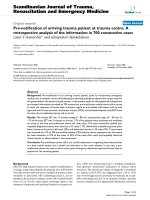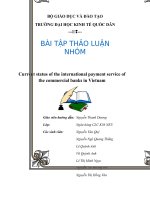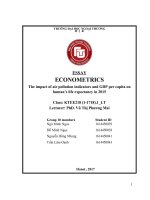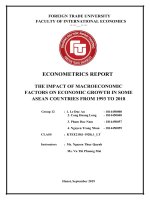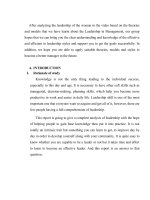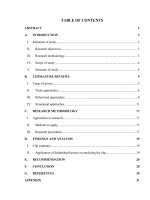(Tiểu luận FTU) analysis of the leadership in boss da market
Bạn đang xem bản rút gọn của tài liệu. Xem và tải ngay bản đầy đủ của tài liệu tại đây (376.97 KB, 34 trang )
FOREIGN TRADE UNIVERSITY
FACULTY OF BUSINESS ADMINISTRATION
------------o0o------------
MID-TERM REPORT
ANALYSIS OF THE LEADERSHIP IN
“BOSS DA MARKET”
Submitted by : Group 3
Class
: Management_QTRE303.2
Instructor
: Mr. Hoang Anh Duy
Hanoi, March 2019
LUAN VAN CHAT LUONG download : add
Management
1
Group 3
TABLE OF CONTENTS
ABSTRACT
2
A.
3
I.
INTRODUCTION
Rationale of study.....................................................................................................3
II.
Research objectives...............................................................................................3
III.
Research methodology..........................................................................................3
IV.
Scope of study.......................................................................................................4
V.
Structure of study..................................................................................................4
B.
I.
LITERATURE REVIEWS
5
Types of power.........................................................................................................5
II.
Traits approaches..................................................................................................6
III.
Behavioral approaches..........................................................................................8
IV.
Situational approaches.........................................................................................11
C.
I.
RESEARCH METHODOLOGY
17
Approaches to research...........................................................................................17
II.
Methods to apply.................................................................................................17
III.
Research procedures............................................................................................17
D.
I.
II.
FINDINGS AND ANALYSIS
19
Clip summary.........................................................................................................19
Application of leadership theories on analyzing the clip.....................................19
E.
RECOMMENDATION
26
F.
CONCLUSION
28
G.
REFERENCES
30
APPENDIX
31
LUAN VAN CHAT LUONG download : add
Management
2
Group 3
ABSTRACT
This is the report for the application of the models of leadership from the course
Management.
The third basic managerial function is leading. The skills of influencing people for
a particular purpose or reason is called leading. Leading is considered to be the
most important and challenging of all managerial activities. Leading is influencing
or prompting the member of the organization to work together with the interest of
the organization, and this report illustrates the comprehension of leadership in
organization management. Our group has chosen the video named “Boss da
market” to concentrate on the woman’s leadership styles in the video. A brief
outline about the topic, objectives and scope of this report is initially outlined. The
methods used for this research and analysis is briefly described in Research
Methodology. The discussion is mainly emphasized on the leadership theories,
which is illustrated in Literature Reviews with the perspectives and research of
various authors in different periods. The most essential in our report is Findings
and Analysis in which we have illustrated the behavior of the woman following the
leadership theories. Moreover, with our knowledge, understanding and analysis, we
would like to make some recommendations to achieve more effective and efficient
management.
After analyzing the leadership of the woman in the video based on the theories
and models that we have learnt about the Leadership in Management, our group
hopes that we can bring you the clear understanding and knowledge of the effective
and efficient in leadership styles and support you to get the goals successfully. In
addition, we hope you are able to apply suitable theories, models and styles to
become a better manager in the future.
LUAN VAN CHAT LUONG download : add
Management
3
Group 3
A. INTRODUCTION
I.
Rationale of study
Knowledge is not the only thing leading to the individual success,
especially in this day and age. It is necessary to have other soft skills such as
managerial, decision-making, planning skills, which help you become more
productive in work and easier in daily life. Leadership skill is one of the most
important one that everyone want to acquire and get all of it, however, there are
few people having a full comprehension of leadership.
This report is going to give a complete analysis of leadership with the hope
of helping people to gain base knowledge then put it into practice. It is not
totally an intrinsic trait but something you can learn to get, to improve day by
day in order to develop yourself along with your community. It is quite easy to
know whether you are capable to be a leader or not but it takes time and effort
to learn to become an effective leader. And this report is an answer to that
question.
II.
Research objectives
This study was carried out to deliver a fundamental comprehension of
leading in an easy and practical way with the purpose of providing basic
knowledge and various approaches to apply leadership skill in reality.
III.
Research methodology
Through a video of familiar scenes in daily life, the study covers all aspects
of life and all kinds of human irrespective of ages, genders and jobs escpecially
the ones who are intended to become a good leader but have no idea where to
begin.
LUAN VAN CHAT LUONG download : add
Management
IV.
4
Group 3
Scope of study
1. Qualitative Method:
Using this type of methods, we concentrate on describing a specific
situation through observations to gain an understanding of problem; therefore,
help to develop ideas for potential quantitative research.
2. References and Observation Method:
Methods to analyze include specific theoretical perspectives and explaining
leading types. We combined references and observation so that we could finish
our task professionally and apply the knowledge and lessons we have learnt
into the real life. While references gave us a reliable source of information
helping to understand the skills and the topic better, we took advantages of
observation from reality and movies to be able to have a practical overview of
the leading process.
V.
Structure of study
This report will summarize out process to create the final product and
express our point of views eight parts: Abstract, Introduction, Literature
Review, Research Methodology, Findings and Analysis, Recommendations,
Conclusion and Appendix. While Abstract starts with the initial problems by
raising a broad question, the other will help narrow down, focus on the root of
problem by our approaching methods (observe, analyze data), then finally
reach the conclusion and giving some recommendations for the concern.
LUAN VAN CHAT LUONG download : add
Management
5
Group 3
B. LITERATURE REVIEWS
I.
Types of power
Leader power is their right and capacity to influence work actions
or decisions. Five sources of leader power have been identified: legitimate,
coercive, reward, expert, and referent.
1. Legitimate power:
Legitimate is similar to authority. Legitimate power represents the power
a leader has as a result of his or her position in the organization. Although
people in positions of authority are also likely to have reward and coercive
power, legitimate power is broader than the power to coerce and reward.
In the video, the main character is the market owner and she has the right
to collect rents as well as invite others to join her market.
2. Coercive power:
Coercive power is used to punish or control. Followers react to this
power out of fear of the negative results that might occur if they don’t comply.
Managers typically have some coercive power, such as being able to suspend
or demote employees or to assign them work they find unpleasant or
undesirable.
When the butcher continued to used wrong scale, the woman broke up the
scale and threatened him not to do that again.
3. Reward power:
Reward power is the power to give positive rewards. A reward can be
anything that a person values such as money, favorable performance appraisals,
LUAN VAN CHAT LUONG download : add
Management
6
Group 3
promotions, interesting work assignments, friendly colleagues, and preferred
work shifts or sales territories.
The woman did encourage sellers in the market, which represents spiritual
reward for them.
4. Expert power:
Expert power is power based on expertise, special skills, or knowledge. If
an
employee has skills, knowledge, or expertise that is critical to a work group,
that person’s expert power is enhanced.
The woman in the video must have so much experience in sales for years
that she was able to open a market for other sellers to help them with job
opportunities. This expert power itself results in referent power.
5. Referent power:
Referent power arises because of personal desirable resources or personal
traits. If I admire you and want to be associated with you, you can exercise
power over me because I want to please you. Referent power develops out of
admiration of another and a desire to be like that person.
Although the market owner in the video is rude, all seller in the market still
respect her for what she did for them. For instance, she asked the coconut man
to join her market due to his poor conditions.
II.
Traits approaches
Arising from the “Great Man” theory, the trait approach is a way of
identifying the key characteristics of successful leaders. It concentrates on the
idea that great leaders are born with the given abilities, and not a learned
LUAN VAN CHAT LUONG download : add
Management
7
Group 3
ability. Individuals are brought into this world with all of the characteristics
needed to become a great leader.
The trait approach theory, of course, comes with a fair share of controversy.
Numerous studies have tried to narrow down the specific personality traits that
make up a good leader. Nevertheless, the results have always been
controversial. Although those that were found might be good traits, they are
not necessarily exhibited by all leaders.
However in those studies, there were 7 factors that appeared more than the
others, namely ‘drive’, ‘self-confidence’, ‘honesty & integrity’, ‘self confidence’, ‘intelligence’, ‘job - relevant knowledge’ and ‘extraversion’. In
more details, the traits are explained as the following:
Drive: Leaders exhibit a high effort level. They have a relatively high desire
for achievement, they are ambitious, they have a lot of energy, they are
tirelessly persistent in their activities, and they show initiative.
Desire to lead: Leaders have a strong desire to influence and lead others.
They demonstrate the willingness to take responsibility.
Honesty and integrity: Leaders build trusting relationships with followers
by being truthful or nondeceitful and by showing high consistency between
word and deed.
Self-confidence: Followers look to leaders for an absence of self-doubt,
Leaders, therefore, need to show self-confidence in order to convince followers
of the rightness of their goals and decisions.
Intelligence: Leaders need to be intelligent enough to gather, syntherize, and
interpret large amount of information, and they need to be able to create
visions, solve problems and make correct decisions.
Job-relevant knowledge: Effective leaders have a high degree of
knowledge about the company, industry, and technical matters. In-depth
LUAN VAN CHAT LUONG download : add
Management
8
Group 3
knowledge allows leaders to make well-informed decisions and to understand
the implications of those decisions.
Extraversion: Leaders are energetic, lively people. They are sociable,
assertive, and rarely silent of withdrawn.
III.
Behavioral approaches
Behavioral Theory of Leadership considers the observable actions and
reactions of leaders and followers in a given situation. Behavioral theories
assume that leaders can be made rather than born, and successful leadership is
based on definable, learnable behavior. For behavioral theorists, a leader
behavior is the best predictor of his leadership influences and as a result, is the
best determinant of his or her leadership success.
These theories concentrate on what leaders actually do rather than on their
personalities. Different patterns of behavior are observed and categorized as
“styles of leadership”.
1. University of Iowa studies
The Iowa Studies of leadership were carried out in the 1939's by Lewin,
Lippitt, and White, under the direction of Lewin. This study was set out to
identify different styles of leadership and it established three major leadership
styles.
· The autocratic leader tends to make choices or decisions based on their
own beliefs and do not involve others for their suggestion or advice.
· The democratic leader takes all opinions into consideration, making a
decision based on others’ input and sharing out the responsibility equally.
LUAN VAN CHAT LUONG download : add
Management
9
Group 3
Democratic leaders let the group determine work methods, make overall goals
known, and use feedback to help subordinates.
· The Laissez-faire leader barely uses their power and gives the group
complete freedom. They try to give the least possible guidance to subordinates
and to achieve control through less obvious means. They believe that people
excel when they are left alone to respond to their responsibilities and
obligations in their own ways.
The University of Iowa studies explored three leadership styles to find
which was the most effective. In fact, it depends on the situation. Autocratic
leadership is best applied to situations where there is little time for group
decision-making or where the leader is the most knowledgeable member of the
group. It also shows that Laissez-faire leadership was the least effective of all
three, while group members were more satisfied under a democratic leader than
under an autocratic one.
2. The Managerial Grid
The managerial grid, developed by Robert Blake and Jane Srygley
Mouton, is a popular approach for defining leadership styles. They argue that
managerial behavior is a function of two variables: concern for people and
concern for production.
Concern for people is the degree to which a leader considers the needs
of team members, their interests, and areas of personal development
when deciding the best way to accomplish a task.
Concern for production is the degree to which a leader emphasizes
concrete objectives, organizational efficiency, and hihg productivity
when deciding the best way to accomplish a task.
LUAN VAN CHAT LUONG download : add
Management
10
Group 3
The level of concern for people (employees) is shown on the vertical axis
and the level of concern for production on the horizontal axis of the grid. Each
axis has a scale ranging from 1 to 9, with the higher numbers indicating greater
concern for the specified variable. Depending on the degree of the managerial
concern for people and production, a manager can fall anywhere on the grid.
The five resulting leadership styles are as follows:
Impoverished management (low concern for people and low concern for
tasks or production): This management style does not provide leadership in a
positive sense but believes in a “laissez-faire” approach, relying on previous
practice to keep the organization going.
Country club management (high concern for people but low concern for
production): managers try to create a work atmosphere in which everyone is
relaxed, friendly, and happy. However, no one is bothered about putting in
the effort required to accomplish enterprise goals.
Task management (high concern for production but low concern for people
in this management style)
LUAN VAN CHAT LUONG download : add
Management
11
Group 3
Middle-of-the- road management (intermediate amount of concern for
both production and people): Managers with this management style believe
in compromise, so that decisions are taken but only if endorsed by
subordinates.
Team management (a high concern for both production as well as
employee morale and satisfaction): Team managers believe that concern for
people and for tasks are compatible. They believe that tasks need to be
carefully explained and decisions endorsed by subordinates to achieve a high
level of commitment.
According to Blake and Mouton, 9, 9 orientations is the most desirable
one.
3. University of Michigan studies
Michigan Leadership Studies indicates the Institute for Social Research at
the University of Michigan conducted empirical studies to identify styles of
leader behavior that results in higher performance and satisfaction of a group.
The studies identified two distinct styles of leadership;
Job-oriented Leadership: Managers pay close attention to subordinates’
work, explain work procedures and are keenly interested in performance.
Employee-oriented Leadership: Managers develop a cohesive group and
ensure that employees are satisfied with their jobs.
The Michigan Leadership Studies found that both the styles of leadership
led to increase in production, but it was slightly more in case of production of
job-orineted style.
LUAN VAN CHAT LUONG download : add
Management
IV.
12
Group 3
Situational approaches
1. Situational Leadership Theories (SLT)
Situational Leadership Theory, or the Situational Leadership Model, is a
model created by Paul Hersey and Ken Blanchard, developed while working
on Management of Organizational Behavior. The theory was first introduced
in 1969 as "life cycle theory of leadership". During the mid-1970s, life cycle
theory of leadership was renamed "Situational Leadership Theory. This is a
contingency theory that focuses on followers’ readiness, and has gained a
strong following among management development specialists
The Situational Leadership Model has two fundamental concepts:
leadership style and the individual or group's performance readiness level,
also referred to as maturity level or development level. Hersey and Blanchard
characterized leadership style in terms of the amount of task behavior and
relationship behavior that the leader provides to their followers. They
categorized all leadership styles into four behavior styles, which they named
S1 to S4 :
S1 - Telling (high task – low relationship): The leader defines roles
and tells people what, how, when, and where to do various tasks.
S2 - Selling (high task – high relationship): The leader provides both
directive and supportive behavior.
S3 - Participating (low task – high relationship): The leader and
followers share in decision making; the main role of the leader is
facilitating and communicating.
S4 - Delegating (low task – low relationship): The leader provides
little direction or support.
LUAN VAN CHAT LUONG download : add
Management
13
Group 3
Of these, no one style is considered optimal for all leaders to use all the
time. Effective leaders need to be flexible, and must adapt themselves
according to the situation.
The right leadership style will depend on the person or group being led.
The Hersey–Blanchard situational leadership theory identified four maturity
levels, or the four stages of follower readiness :
R1: people are both unwilling and unable to take responsibility for
doing something. Followers aren’t competent or confident.
R2: people are unable but willing to do the necessary job tasks.
Followers are motivated but lack the appropriate skills.
R3: People are able but unwilling to do what the leader wants.
Followers are competent, but don’t want to do something.
R4: People are both able and willing to do what is asked of them.
Maturity levels are also task-specific. A person might be generally
skilled, confident and motivated in their job, but would still have a maturity
level M1 when asked to perform a task requiring skills they don't possess.
SLT essentially views the leader–follower relationship as like that of a
parent and a child. Just as a parent needs to relinquish control when a child
becomes more mature and responsible, so, too, should leaders. As followers
reach higher levels of readiness, the leader responds not only by decreasing
control over their activities but also decreasing relationship behaviors. The
SLT says if followers are at R1 (unable and unwilling to do a task), the
leader needs to use the telling style and give clear and specific directions; if
followers are at R2 (unable and willing), the leader needs to use the selling
style and display high task orientation to compensate for the followers’ lack
LUAN VAN CHAT LUONG download : add
Management
14
Group 3
of ability and high relationship orientation to get followers to “buy into” the
leader’s desires; if followers are at R3 (able and unwilling), the leader needs
to use the participating style to gain their support; and if employees are at R4
(both able and willing), the leader doesn’t need to do much and should use
the delegating style.
2. Path-goal medal
Path-goal theory is a leadership theory developed by Robert House in
1971 and revised in 1996. The theory states that the leader’s job is to assist
followers in attaining their goals and to provide direction or support needed
to ensure that their goals are compatible with the goals of the group or
organization. The task-oriented elements of the Path-Goal Theory match
situational leadership. The Path-Goal Theory provides ways for leaders to
encourage and support their employees in achieving their goals. That also
includes rewards.
According to House’s path-goal theory, a leader’s effectiveness depends
on several employee and environmental contingent factors and certain
leadership styles. All these are explained in the figure below:
LUAN VAN CHAT LUONG download : add
Management
15
Group 3
House identified four leadership behaviors:
Directive leader: Lets subordinates know what’s expected of them,
schedules work to be done, and gives specific guidance on how to
accomplish tasks.
Supportive leader: Shows concern for the needs of followers and is
friendly.
Participative leader: Consults with group members and uses their
suggestions before making a decision.
Achievement oriented leader: Sets challenging goals and expects
followers to perform at their highest level.
According to the theory, these leadership styles are not mutually
excusive and leaders are capable of selecting more than one kind of a style
suited for a particular situation.
LUAN VAN CHAT LUONG download : add
Management
16
Group 3
The theory also states that each of these styles will be effective in some
situations but not in others. It further states that the relationship between a
leader’s style and effectiveness is dependent on the following variables:
Employee characteristics: These include factors such as employees’
needs, locus of control, experience, perceived ability, satisfaction,
willingness to leave the organization, and anxiety. For example, if
followers are high inability, a directive style of leadership may be
unnecessary; instead a supportive approach may be preferable.
Characteristics of work environment: These include factors such as
task structure and team dynamics that are outside the control of the
employee. For example, for employees performing simple and routine
tasks, a supportive style is much effective than a directive one.
Similarly, the participative style works much better for non-routine
tasks than routine ones.
When team cohesiveness is low, a supportive leadership style must be
used whereas in a situation where performance-oriented team norms exist, a
directive style or possibly an achievement-oriented style works better.
Leaders should apply directive style to counteract team norms that oppose
the team’s formal objectives.
In conclusion, the theory has been subjected to empirical testing in
several studies and has received considerable research support. This theory
consistently reminds the leaders that their main role as a leader is to assist
the subordinates in defining their goals and then to assist them in
accomplishing those goals in the most efficient and effective manner. This
theory gives a guide map to the leaders about how to increase subordinates
satisfaction and performance level.
LUAN VAN CHAT LUONG download : add
Management
I.
17
Group 3
C. RESEARCH METHODOLOGY
Approaches to research
The purpose of the research is to analyze the leadership traits and styles of
a given person based on the existing studies and theories on leadership.
Leadership is an area belonging to the field of social behaviour research.
Moreover, in identifying the traits and styles of leadership, we aim to explore
and understand the meaning of individuals ascribe to the social problem.
Therefore, the qualitative approach was chosen to apply to this specific
research.
II.
Methods to apply
Based on the requirements of the research paper, we have decided to use
the observation method, which may include recording, description, analysis
and interpretation of people’s behaviour. This method can be loosely structured
or tightly structure with precise coding methods of behavioural patterns.
Alongside with this method, we use the professional knowledge of leadership
skills as a foundation to our research. When the knowledge base provides us
with an overview of leadership skills, direct observation and analysis helps us
to have a deeper and realistic view of the leadership process and its impact on
surroundings.
III.
Research procedures
On preparing for the research, we did a preliminary search for information
including existing studies and theories on leadership skills. Then, we began
with setting out some criterias for finding the suitable video. The first one is the
relevance of the clip to our chosen topic, which means it needs to match our
collected information, the points are clear and do not cause any
misunderstanding. The second of our choice is the attractiveness regarding both
LUAN VAN CHAT LUONG download : add
Management
18
Group 3
content and visual as to make ease for delivery of analysis and findings. Last
but not least, the video needs to be clear in quality, the subtitle if included
should be easily seen and the conversations should be able to be followed.
Next, after selecting some options, we did a thorough evaluation and finally
agreed on the video “Boss Da Market” considering its match to our criterias.
The following up actions were taken to break down the details and information
harnested from the clip. Applying the findings and theories on leadership, we
concluded the analyis results as will be discussed below.
LUAN VAN CHAT LUONG download : add
Management
19
Group 3
D. FINDINGS AND ANALYSIS
I.
Clip summary
Boss Da owns a small market, with the help of two assistants. One day,
when coming to collect the rent as usual, she figured out many problems in the
merchandising in her market, such as wrong weighing, dirty roads, slackness,
etc. She tried to fix those problems in her own way. Unexpectedly, videos of
her breaking a stall owner’s scale, taking their goods away, carrying a person in
bad health condition head to somewhere were uploaded on the social media.
They caused serious misunderstanding and hatred towards Boss Da, which
made her be cursed and be considered “cruel, inhumane”. Moreover, people
boycotted and refused to go to her market and even wished her to go bankrupt.
However, what was shown on those videos turned out to be only a small part of
the story. Having known what was happening, Boss Da still decided to act the
way she has always done: be a guide to her subordinates and a warm-hearted
person to other people who are in a hopeless plight.
II.
Application of leadership theories on analyzing the clip
1. Power of the leader
LUAN VAN CHAT LUONG download : add
Management
20
Group 3
Based on the video clip, it can be seen that the woman owns 3 sources
of leader power, which are: legitimate, referent and coercive powers. More
specifically:
Legitimate power: The woman is the boss of the market. From the
clip, it is obvious she has the right to collect stall rent and ask people
to sell their products at the market. As a result of her position, she
even gets to tell renters what to do in the market. For example, she
demands that the place should be cleaned and the butcher should stop
cheating his customers.
Referent power: It appears that the renters of the market still
respected the woman even when she yelled at them. There were no
signs of them talking behind her back or speaking out against the way
she ran the market.
This resulted from the fact that she was actually a kind - hearted boss.
It can be seen from the clip that she always helped out the poor by offering
to lend them empty stalls in market so that they could have a place to sell
LUAN VAN CHAT LUONG download : add
Management
21
Group 3
their products. When it came to the stall rent that she received from her
renters, she showed her honesty. If they overpaid her, she would
immediately pay them back the surplus. In addition, she even told her
minions to take care of a man who fainted from working too hard. Thanks to
her personal traits, all of her renters respected and admired her.
Coercive power: The woman had the right to punish and control the
way her renters ran the market. She broke the butcher’s scale because he was
cheating his customers. Obviously, the butcher reacted out of fear when she
found out about his tricks.
2. Trait approaches – trait theory
As what have been stated in the Literature Review, there are no consistent
sets of traits that all leaders should exhibit, only 7 traits (‘drive’, ‘desire to
lead’, ‘honesty & integrity’, ‘self - confidence’, ‘intelligence’, ‘job - relevant
knowledge’, ‘extraversion’) that appear more than any others. In this video
clip, the woman showed that she owned all these 7 traits. However, since the
content of the video is not straightforward, they are only revealed near the
end of the clip. For further explanation:
Drive: The woman insisted that she attain her money from lending
kiosks in the market. Furthermore, she also had a lot of energy and power to
persist with achieving her goal.
Desire to lead: She forced the “curly man” to open the door even
though he was watching clips. Also when she came into the market, she
shouted at other people, complaining about the dirt and demanded that they
keep the market clean. Subsequently, she kept on asking for the rent expense
from each renter.
LUAN VAN CHAT LUONG download : add
Management
22
Group 3
She also had a very strong characteristic and it was displayed in the scene in
which she broke the scale of the butcher, ordering him not to rip off his
customers.
Honesty and integrity: This trait is not very straightforward in most
of the video. However, it was clarified at the end when the scenes revealed
her kind - hearted actions towards her renters. She sympathized with other
people, understood their backgrounds and burdens, helped them out and
therefore, built a greater relationship with them.
Self-confidence: She always believed in what she thinks, although
sometimes this belief was shown a little bit rude. She kept on doing things
the same way as before even when videos on the Internet distorted the truth
about her. In addition, it was easy to see the confidence in her eyes and her
behaviours.
Intelligence: It was easy to identify this trait of leaders in the whole
video. However, only when the woman watched the video on social media
did the viewers have a full understanding of this trait of hers. She was very
composed and made a lot of intelligent decisions after watching her video on
Facebook. Even though she was misunderstood by the public, she refused to
make the fuss out of it and retained her way of running the market.
Job-relevant knowledge: She knew exactly what happened inside the
market, from the cleanliness of the market to the rent of each person.
Extraversion: Without a doubt, this trait was shown continuously
throughout in this video. The woman gave the impression of a very energetic
boss with her loud voice and the lively look on her face.
3. Behavioral approaches – Iowa University Studies
LUAN VAN CHAT LUONG download : add
Management
23
Group 3
Among the main studies using the behavioral approaches, the leadership
style of the Boss Da Market is showed clearly through theory from Iowa
University, Michigan University and the Managerial Grid. It can be seen that
there is a flexibility in her style of leading. We can describe the behavior of the
boss from Boss da market with three types: Autocratic style, Employee oriented,
and Concern for people from Managerial Grid.
3.1. Autocratic style (Iowa University studies)
Firstly, “autocratic style” is from the beginning to 1.30’. Let’s remember the
theory from Iowa University, which describes that a leader with this style
dictate work methods, make unilateral decisions, and limit employee
participation. From the beginning of the videos, she request the employees to
turn off the music because “We’re collecting rent, not going to battle”. We can
also see that she instructs strictly about the cleanliness of the market many times
: “What is this dirt ? How many times do I need to say it ?”, “Everything has to
be clean!”, “How many times have I told you not put the trash can in front of
the stall?”. These are very dominant examples of autocratic leadership style.
Furthermore, when collecting the rental fee from stall owners, she uses a very
high tone of voice and angry facial expression, which makes them be unable to
say something, so they just follow her orders without the participation.
3.2. Employee-oriented (Michigan University studies)
However, from 3.45’ to the end of the video, we can see that her leadership is
Employee oriented. She cares a lot about interpersonal relationships and taking
care of employees’ needs. The Michigan researchers concluded that leaders who
were employee oriented were able to get high group productivity and high
group member satisfaction. We can see that she recruits people who are in a
difficulty to enable them to make a living like the man with a cart, the deaf
LUAN VAN CHAT LUONG download : add
Management
24
Group 3
woman, offers them a place in the market to sell their products, give massage to
the old man who got fainted. She does not hesitate to help the stall owners, for
examples, she bought all the fruit left of the woman with a baby and said “We
can help each other”. Finally, we can recognize their trust and a feeling of
gratitude to the boss from their look even after the disturbance.
4. Situational approaches
Via the situational approaches, it is found that the Boss Da Market’s
leadership style can be analyzed clearly using the situational leadership theory
(SLT) and path-goal model.
4.1. Situational leadership Theory (SLT Theory)
Applying this theory, we can see that the Boss Da Market use 2 different
leadership style : Telling and Selling
From the beginning to 1.30’, the boss uses the telling style, because she just
tells her followers what they have to do, force them to submit the tasks on time
without thinking of their problematic issues and progress. Her employees are
low-income workers, so they do not have much money. The rental fees may
account for a major part of their income, therefore, they are unable and
unwilling to pay the boss. In order to collect the rental fee, she needs to request
them in a very aggressive way. Moreover, they are unaware that the dirty and
environment can do harm to themselves and their business as well, so she
instructs strictly about the cleanliness of the market many times.
From 3.45’ to the end of the video, the boss use the selling style, where she
looks at things that the followers can do best and things that she is needing, give
them her direction and listen to their thoughts in order to decide whether to act
or not. She supports the stall owners like the man with a cart, the deaf woman
LUAN VAN CHAT LUONG download : add
